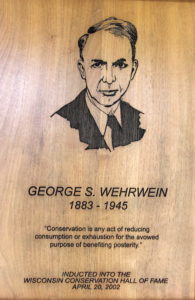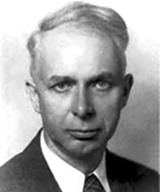1883 – 1945
Inducted 2002
“(Conservation) involves more than merely combining the factors of production and elimination of waste. It involves the deliberate use of restraint in the present in order to leave a supply for future generations.” – George Wehrwein
George Wehrwein’s conservation interests were many, but two stand out. Wehrwein was a land economist – an advocate of wise and efficient use of land. He was also concerned about soil conservation, and he deplored the depletion and misuse of this resource.
A native of Newton, in Manitowoc County, WI, Wehrwein spent most of his life in academic circles, primarily at the University of Wisconsin-Madison. Here he would focus on the emerging discipline of land economics. He wrote the first textbook on the subject. “Land Economics” was published in 1940. In it, he advanced the theory that land use policy can be used to make wise decisions about the use of natural resources. He was the nation’s leading teacher of land economics in the 1920s, ’30s and ’40s. It’s estimated that more than 1,400 students enrolled in Wehrwein’s land economics courses over the years.
However, his influence would be felt well beyond the academic world. He was a strong collaborator, evidenced by the fact that many of the projects he worked on involved the combining of several disciplines or working with those from other backgrounds. An example: He collaborated with Aldo Leopold (WCHF Inductee), a professor of wildlife management, political scientist John M. Gaust and other like-minded faculty at Madison to offer a distinctive interdisciplinary program in rural regional planning. He was an early advocate of this approach.
 Early economic literature often treated all land as if it was the same. Wehrwein’s message was that other things must be taken into consideration. “In other words, the supply and demand of land is a function of how land responds when you try to do something with it, such as the difference between trying to grow corn in the northern and in the southern sections of Wisconsin, a fact commonly overlooked by economists,” he wrote.
Early economic literature often treated all land as if it was the same. Wehrwein’s message was that other things must be taken into consideration. “In other words, the supply and demand of land is a function of how land responds when you try to do something with it, such as the difference between trying to grow corn in the northern and in the southern sections of Wisconsin, a fact commonly overlooked by economists,” he wrote.
Wehrwein worked with state and local officials to find ways to make useful thousands of acres of denuded, tax-delinquent land in the north. He assisted the Wisconsin Committee on Forest Land Use and Wisconsin State Planning Board from 1935 until his death. These efforts led to the establishment of county zoning, the first example of rural land use zoning in the nation. Some forested land was shifted to state and national reserves. A county forest program was developed as a way to get tax-delinquent land back into productive use. At the same time, a forest crop taxation program was devised to encourage continued private ownership and management of forests.
Wehrwein also worked on conservation and land use at the national level. He was a consultant to the federal government during the administration of President Franklin D. Roosevelt and contributed to implementing the New Deal land use and conservation program. His work at the national level included a pioneering article, “The Rural-Urban Fringe,” published in the journal “Economic Geography,” in 1942. It is credited with providing the theoretical framework for researchers worldwide who continue to this day to address the conflicts between rural land uses and urban expansion.
Resources
George Wehrwein Legislative Citation
George S. Wehrwein, Conservation Prophet, WCHF Induction speech by son, Austin C. Wehrwein, 2002
The Wehrwein Web, family history (see pg. 32)
George Simon Wehrwein Ph.D., photos and articles
Econonmist inducted into hall of fame, article by Marge Miley for Manitowoc Herald Times, 2002
George S. Wehrwein and Aldo Leopold on Property Rights, and America’s Future Land Use and Conservation, article by Gerald E. Vaughn, 1999
The Economist’s Approach to Ecology, article by Gerald F. Vaughn for Choices, 1995
All Flesh is Grass, WPR program transcript, 1976
George S. Wehrwein, 1883-1945, tribute by A. W. Schorger (WCHF Inductee) for Wiscosin Conservation Bulletin, 1973
A Tribute to Wisconsin Conservation Leaders, speech by A. W. Schorger (WCHF Inductee), 1949
Memorial Resolution of the University Faculty Meeting, 1945
County Zoning in Wisconsin: Agriculture, Forestry and Recreation, article by George S. Wehrwein for Minnesota Municipalities, 1934


